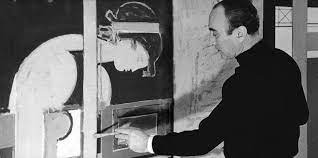Yannis Moralis was born in Arta in 1916. He studied painting and engraving with Argyros, Geraniotis, Parthenis and Kefallinos at the ASKT of Athens (1931-1936). In 1937, with a scholarship from the Academy of Athens, he went first to Rome and then to Paris, where he attended classes in fresco painting at the École des Beaux Arts and mosaics at the École des Arts et Metiers. He returned to Greece at the beginning of the War.
His talent had been recognized since the 1930s and 1940s, when he presented his works in group exhibitions. In 1947 he was elected a professor at ASKT, where he worked for 36 years, teaching painting to several generations of younger artists.
In 1949 he participated in the founding of the “Armos” group and in 1958 he represented Greece at the Venice Biennale (together with Tsarouchis and Antonis Sochos). The following year he had his first solo exhibition in Athens (1959, Armos).
His work starts from the painting concerns of the generation of the 30s, with an obvious tendency to search for the essential elements of the image, on a visual and expressive level. Gradually his compositions acquire a monumental character and refer to ancient Greek reliefs. The human form, especially the female form, dominates all of his paintings. Since the early 1970s his work has focused on structural and plastic values. The geometry of the compositions is emphasized and the forms are stylized to the fullest, tending to merge with the space. The subjects, female nudes or erotic complexes, are integrated into harmonious combinations of geometric shapes with flat colors, yet remaining recognizable.
In addition to painting and engraving, he also worked on sets and costumes, mainly for the Art Theater and the National Theater. He also made illustrations, posters, murals and sculptures.
His decorative compositions can be found in many interior and exterior spaces of public buildings and in the University station of the Athens Metro.
His work, which perfectly expresses the sensibility of his generation, was appreciated by poets and intellectuals and loved by the public. He held 10 individual exhibitions (mainly at the Zoumboulakis gallery) and participated in a few group exhibitions. In 1988, all aspects of his art were presented retrospectively at the National Gallery, to which the painter donated a part of his work. At the same time, a large volume was published with the entirety of his work. His last important exhibitions were held at the Academy of Athens (1996) and at the Benaki Museum (2001).
He was honored with distinctions such as the medal of the Order of the Phoenix (1965), the Excellence of Arts of the Academy of Athens (1979) and the order of the Order of Honor (1999). He died in Athens in 2009.
Γεννήθηκε στην Άρτα το 1916. Σπούδασε στην ΑΣΚΤ της Αθήνας, ζωγραφική και χαρακτική με τους Αργυρό, Γερανιώτη, Παρθένη και Κεφαλληνό (1931-1936). Το 1937, με υποτροφία της Ακαδημίας Αθηνών, πήγε πρώτα στη Ρώμη και μετά στο Παρίσι, όπου παρακολούθησε μαθήματα νωπογραφίας στην École des Beaux Arts και ψηφιδωτού στην École des Arts et Metiers. Επέστρεψε στην Ελλάδα με την έναρξη του Πολέμου.
Το ταλέντο του είχε αναγνωριστεί από τα χρόνια του ’30 και του ’40, όταν παρουσίαζε έργα του σε ομαδικές εκθέσεις. Το 1947 εκλέχτηκε καθηγητής στην ΑΣΚΤ, όπου εργάστηκε επί 36 χρόνια, διδάσκοντας ζωγραφική σε πολλές γενιές νεότερων καλλιτεχνών.
Το 1949 συμμετείχε στην ίδρυση της ομάδας «Αρμός» και το 1958 εκπροσώπησε την Ελλάδα στη Μπιενάλε της Βενετίας (μαζί με τον Τσαρούχη και τον Αντώνη Σώχο). Το επόμενο έτος έκανε την πρώτη του ατομική έκθεση στην Αθήνα (1959, Αρμός).
Tο έργο του ξεκινάει από τους ζωγραφικούς προβληματισμούς της γενιάς του ’30, με μια εμφανή τάση αναζήτησης των ουσιαστικών στοιχείων της εικόνας, σε εικαστικό και εκφραστικό επίπεδο. Βαθμιαία οι συνθέσεις του αποκτούν μνημειακό χαρακτήρα και παραπέμπουν σε αρχαία ελληνικά ανάγλυφα. Η ανθρώπινη μορφή, κυρίως η γυναικεία, κυριαρχεί στο σύνολο της ζωγραφικής του. Από τις αρχές της δεκαετίας του 1970 το έργο του επικεντρώνεται στις δομικές και πλαστικές αξίες. Η γεωμετρία των συνθέσεων τονίζεται και οι μορφές σχηματοποιούνται στο έπακρο, τείνοντας να ενωθούν με το χώρο. Τα θέματα, γυναικεία γυμνά ή ερωτικά συμπλέγματα, εντάσσονται σε αρμονικές συζεύξεις γεωμετρικών σχημάτων με επίπεδα χρώματα, παραμένοντας ωστόσο αναγνωρίσιμα.
Εκτός από τη ζωγραφική και τη χαρακτική, ασχολήθηκε και με σκηνικά και κοστούμια, κυρίως για το Θέατρο Τέχνης και το Εθνικό Θέατρο. Έκανε επίσης εικονογραφήσεις, αφίσες, τοιχογραφίες και γλυπτά.
Διακοσμητικές συνθέσεις του βρίσκονται σε πολλούς εσωτερικούς και εξωτερικούς χώρους δημοσίων κτιρίων και στο σταθμό Πανεπιστήμιο του αθηναϊκού Μετρό.
Το έργο του, που εκφράζει άριστα την ευαισθησία της γενιάς του, εκτιμήθηκε από ποιητές και διανοούμενους και αγαπήθηκε από το κοινό. Έκανε 10 ατομικές εκθέσεις (κυρίως στη γκαλερί Ζουμπουλάκη) και συμμετείχε σε λίγες ομαδικές. Το 1988 παρουσιάστηκαν αναδρομικά όλες οι πλευρές της τέχνης του στην Εθνική Πινακοθήκη, στην οποία ο ζωγράφος δώρησε ένα μέρος του έργου του. Παράλληλα εκδόθηκε ένας μεγάλος τόμος με το σύνολο της δουλειάς του. Οι τελευταίες σημαντικές εκθέσεις του έγιναν στην Ακαδημία Αθηνών (1996) και στο Μουσείο Μπενάκη (2001).
Τιμήθηκε με διακρίσεις όπως το μετάλλιο του Ταξιάρχη του Φοίνικα (1965), το Αριστείο των Τεχνών της Ακαδημίας Αθηνών (1979) και το μετάλλιο του Ταξιάρχη της Τιμής (1999). Πέθανε στην Αθήνα το 2009.
Biography Source | Πηγή Βιογραφικού: Contemporary Greek Art Institute
View all works by Yannis Moralis on Art.gr | Όλα τα έργα του Γιάννη Μόραλη στο Art.gr




